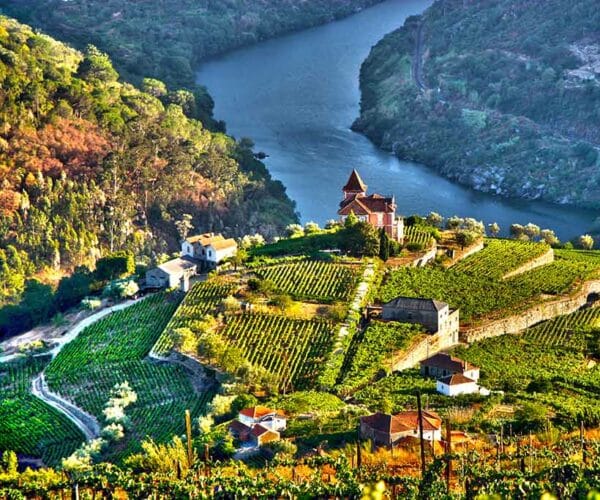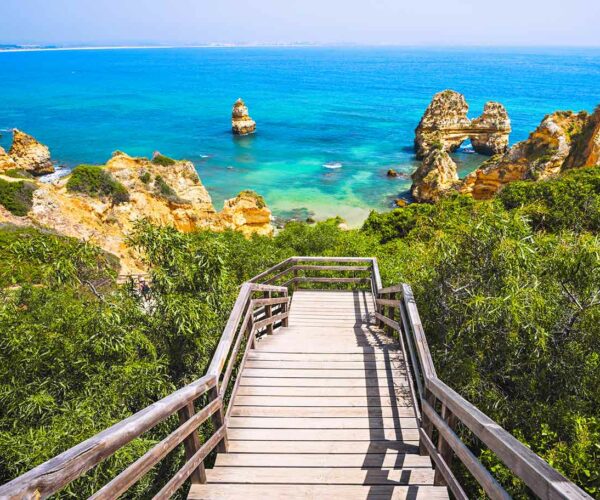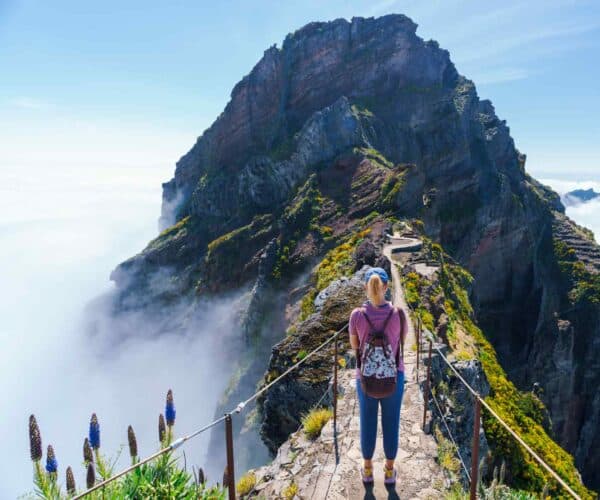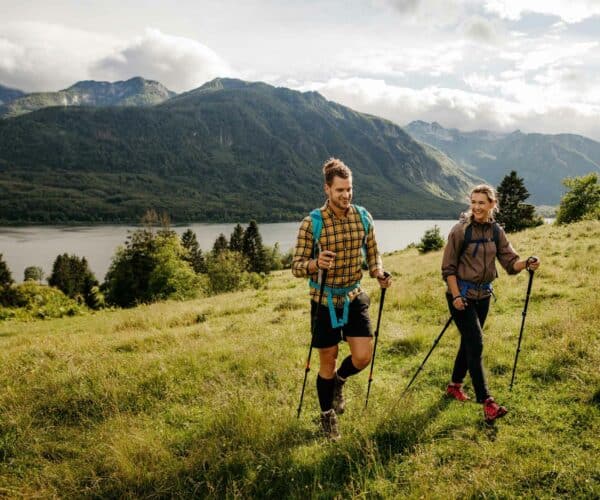Portugal isn’t just about charming cities and golden beaches – hiking in Portugal means discovering a whole world of trails to sink your shoes into.
From misty mountain routes in the north to dramatic ocean cliffs in the south (and even lush volcanic paths on islands like Madeira), the country has trails to match every hiking style and skill level.
Whether you’re chasing summit views, quiet forest paths, or coastal adventures, we’ve rounded up some of the best hikes across Portugal to fire up your wanderlust. You’ll also find practical tips on when to go, what to bring, and how to stay safe.
Famous hiking in Portugal

Peneda-Gerês National Park - The Calcedonia Trail
Distance: ~10 km (circular loop)
Difficulty: Moderate
Why go: Solitude, waterfalls, and ancient ruins in Portugal’s only national park.
The Calcedónia Trail is one of those hikes where every twist in the trail reveals something special: a moss-covered boulder, the distant rush of a waterfall, or the crumbling stonework of a forgotten village. This loop, starting near Termas do Gerês, is tucked deep in Peneda-Gerês National Park. It takes you through dense greenery, alongside the crystal-clear Homem River, and up to a waterfall near the ruins of Calcedonia—a strategic settlement built to confuse would-be invaders.
Expect manageable inclines, peaceful paths, and few fellow hikers. It’s open year-round, and perfect if you’re looking for a less-traveled route that still delivers big on nature and history.
Douro Valley - Douro Vineyards Trail
Distance: 8–17 km (customisable routes)
Difficulty: Moderate
Why go: Rolling vineyards, wine villages, and sweeping river views
If you dream of hiking between vineyard rows with a glass of wine waiting at the end, this is your trail. The Douro Vineyards Trail can start from Provesende or Pinhão, and winds through the UNESCO-listed Douro wine region.
You’ll pass terraced hillsides carved over centuries, climb and descend between charming villages, and look out over one of the oldest demarcated wine regions in the world. Don’t miss Sabrosa, hometown of Ferdinand Magellan, or the chance to refuel with a homemade meal and a bottle of local vinho.
Hiking near Lisbon
Sintra-Cascais Natural Park - The Cape Route
Distance: ~9 km (flexible based on chosen route)
Difficulty: Easy to Moderate
Why go: Coastal cliffs, ancient legends, and epic Atlantic views
Only a short train ride from Lisbon, the Cape Route (Cabo da Roca) is a coastal stunner. Starting in Cascais, this hike takes you through Sintra-Cascais Natural Park, with sweeping sea cliffs, pine forests, and ocean spray.
You’ll hike past iconic landmarks like Boca do Inferno (Hell’s Mouth) and Cabo Raso lighthouse. The cliffs tower up to 100 meters above the Atlantic, and it’s easy to see why ancient mariners once thought this was where the world ended. Perfect for a day hike if you’re staying in the capital.
Hiking in the Algarve

Seven Hanging Valleys Trail
Distance: ~12 km round trip
Difficulty: Moderate (sun exposure and some inclines)
Why go: Limestone cliffs, sea caves, and Instagram-worthy beaches
Think the Algarve is just for beach lounging? Think again. The Seven Hanging Valleys Trail serves up one of the most stunning coastal hikes in Europe. Starting in Carvoeiro and stretching between Marinha and Vale Centeanes beaches, this out-and-back trail clings to limestone cliffs that plunge into turquoise waters.
You’ll pass through seven natural valleys, offering dramatic sea views, caves, arches, and hidden coves. Don’t forget your camera, and maybe your swimsuit for a mid-hike dip at Praia da Marinha.
Rota Vicentina - Fishermen's Trail
Distance: Up to 230 km (choose a section or do it all!)
Difficulty: Varies (sections range from easy to challenging)
Why go: Rugged coastal beauty, remote beaches, and authentic Portuguese culture
If long-distance hiking is your thing, Portugal’s southwest coast is calling. The Fishermen’s Trail is a wild, windy, and wonderful route that hugs the cliffs of the Alentejo and Algarve coastlines. It’s part of the larger Rota Vicentina network and can be tackled in shorter segments or as a full-on multi-day adventure.
Some of the standout stretches – Sagres to Lagos for raw coastal drama, or Carrapateira to Vila do Bispo for sweeping Atlantic vistas and quaint fishing villages. Expect sand dunes, salty air, and maybe a fox or two.
Madeira Walking Tours

Madeira Levada Walks
Distance: ~17.4 km round trip
Difficulty: Moderate
Why go: Waterfalls, tunnels, and enchanted forest vibes
Levada walks are a unique Madeira experience. These irrigation channels cut across the island’s steep terrain, creating narrow, winding trails through lush laurel forests. Levada do Caldeirão Verde is among the most scenic, starting in Queimadas Forest Park and weaving through tunnels and mossy rock walls.
You’ll end at the breathtaking Caldeirão Verde waterfall, with an optional extension to Caldeirão do Inferno for those wanting more adventure. Headlamps come in handy here for the darker tunnels. It’s one of those hikes that feels like a fairytale.
When is the best time for hiking in Portugal?

Spring (March to May): Ideal weather, wildflowers, and fewer crowds. One of the best times to hit the trails.
Autumn (September to November): Cooler temps, colorful landscapes, and quieter routes.
Summer (June to August): Hot, especially inland and in the south. Stick to early morning or coastal hikes, and take plenty of water.
Winter (December to February): Still great in the Algarve and Madeira. Mild temps and less tourist traffic.
What do you need for a hiking in Portugal?

Clothing
Hiking Boots: Sturdy, comfortable, and waterproof.
Moisture-Wicking Base Layers: to keep you dry and comfortable.
Weather-Appropriate Clothing: Lightweight and breathable for summer and layered for colder seasons.
Rain Jacket: Given Portugal’s variable weather, a waterproof jacket is essential.
Hat and Sunglasses: Protection from the sun.
Gloves and Hat: For colder weather.
Socks: Moisture-wicking and comfortable hiking socks.
Equipment
Backpack: With enough capacity for water, snacks, extra layers, and essentials.
Trekking Poles: Especially useful for challenging terrains.
Water Bottle: Stay hydrated, especially in warmer seasons.
Navigation Tools: Compass and map or GPS device.
Headlamp/Flashlight: Essential if you plan to hike in low light or during the night.
Multi-tool or Knife: Handy for various situations.
First Aid Kit: Basic supplies for minor injuries.
Emergency Shelter: A lightweight tarp or space blanket.
Insurance
Travel Insurance: Covers medical emergencies, trip cancellations, and other unexpected events.
Maps & Guides
Detailed Trail Maps: Obtain reliable maps for the specific trails you plan to hike.
Guidebooks: Provide insights into the terrain, difficulty, and points of interest.
Digital Maps: Download offline maps on your phone or GPS device.
Additional Tips
Permits and Permissions: Check if the trails you plan to hike require any permits.
Weather Forecast: Stay updated on the weather to plan accordingly.
Emergency Contacts: Keep local emergency numbers and contacts handy.
Is it safe to hike in Portugal?
Hiking in Portugal is generally considered safe, and the country offers a variety of beautiful trails with diverse landscapes, from coastal paths to mountainous regions. However, like any outdoor activity, it’s important to be aware of certain factors for a safe hiking experience:
Trail Conditions
Varied Terrain: Portugal’s trails can range from well-maintained paths to more challenging terrains, especially in mountainous areas.
Weather Changes: Be prepared for sudden weather changes, as Portugal experiences different climates in its regions.
Ability & Fitness
Trail Difficulty: Choose trails that match your fitness level and hiking experience. Portugal caters to all skill levels, from easy coastal walks to challenging mountain routes.
Fitness Level: Ensure your fitness aligns with the chosen trail. Steep ascents or long distances may require a good level of stamina.
Know Your Limits: Don’t push beyond your capabilities. If a trail seems too challenging, consider a more suitable alternative.
Safety Tips
Inform Someone: Let someone know your hiking plans, including the route and estimated return time.
Stay on Marked Trails: Stick to well-marked paths to avoid getting lost, especially in remote areas.
Weather Awareness: Check weather forecasts before heading out and be prepared for changing conditions.
Carry Essentials: Bring enough water, snacks, a first aid kit, and other necessary gear.
Emergency Contacts: Have local emergency numbers and contacts available.
Travel in Groups: If possible, hike with a companion or in a group for added safety.
Get Hiking & Trekking Insurance with SportsCover Direct
However rigorously you follow safety tips and plan your trip there is always the possibility that something might go wrong, so it is worth taking the time to be prepared. Having comprehensive insurance to support your trip can protect you against unexpected dramas that could result in costly claims.
SportsCover Direct’s trekking and hiking insurance gives you worldwide cover for peaks of up to 7,000 metres. Our travel insurance is designed to give financial protection for medical and repatriation costs, cancelled trips and more. You can also opt for a bolt-on to add to your existing policy.
Find out more and get a personalised quote online.
Bee Ingram
Content Writer for SportsCover Direct
This blog has been created as general information and should not be taken as advice. Make sure you have the correct level of insurance for your requirements and always review policy documentation.